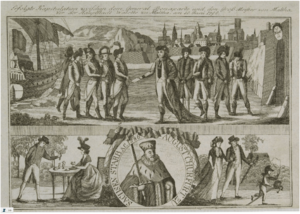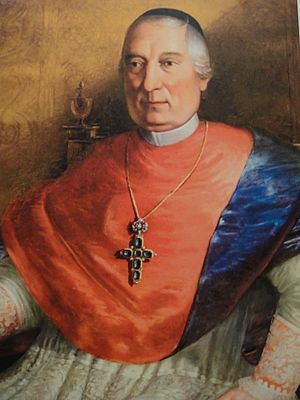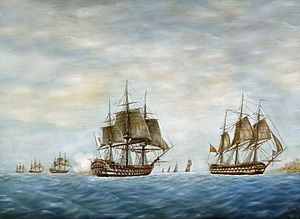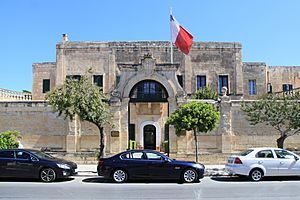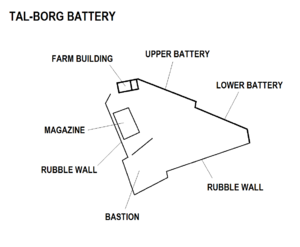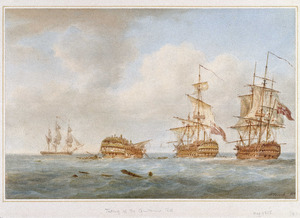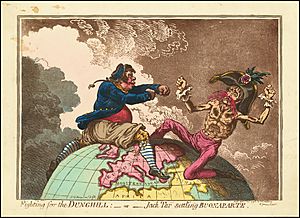Siege of Malta (1798–1800) facts for kids
Quick facts for kids Siege of Malta |
|||||||||
|---|---|---|---|---|---|---|---|---|---|
| Part of the naval operations and the Mediterranean campaign during the War of the First Coalition | |||||||||
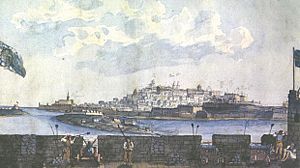 A painting showing French-occupied Valletta and Manoel Island from a rebel position during the blockade. |
|||||||||
|
|||||||||
| Belligerents | |||||||||
| Commanders and leaders | |||||||||
| Strength | |||||||||
| Maltese – 10,000 ~ British – 16 ships Portuguese – 5 ships |
6,000–7,000 | ||||||||
| Casualties and losses | |||||||||
| Maltese – 300 British – light |
4,000 surrendered 2,000 – killed, wounded, sick or dead to disease |
||||||||
| 20,000 Maltese civilians dead to disease | |||||||||
The Siege of Malta, also called the French blockade, was a long military event that lasted for two years. It took place between 1798 and 1800 on the island of Malta. During this time, French soldiers were trapped inside the main city of Valletta and the nearby Three Cities.
Malta had been taken by French forces led by General Napoleon Bonaparte in 1798. About 3,000 French soldiers, commanded by Claude-Henri Belgrand de Vaubois, were left to guard the island. However, the British Royal Navy destroyed the French fleet at the Battle of the Nile in August 1798. This allowed the British to start a blockade around Malta.
The local Maltese people also rose up against French rule. The French soldiers in Valletta soon faced serious food shortages because the British blockade was very effective. Even though some supplies arrived in early 1799, no more ships got through until 1800. By then, hunger and sickness were severely affecting the French troops.
In February 1800, a large group of French supply ships tried to reach Malta from Toulon. But the British ships, led by Rear-Admiral Horatio Nelson, stopped them. The French commander, Jean-Baptiste Perrée, was killed, and his ship was captured. No supplies reached Malta. The next month, a large French warship, the Guillaume Tell, tried to escape Valletta. It was also stopped and forced to surrender after a tough fight.
These defeats at sea made it impossible for the French to hold Valletta. Vaubois surrendered on September 4, 1800, and Malta was taken by Britain.
Contents
Background to the Siege
French Invasion of Malta
On May 19, 1798, a large French fleet sailed from Toulon. It carried over 30,000 soldiers led by General Napoleon Bonaparte. Their goal was to invade Egypt. Bonaparte wanted to increase French power in Asia and make Britain agree to peace in the French Revolutionary Wars, which had started in 1792.
On June 9, the French ships arrived off Valletta, the main port city on Malta. At this time, Malta was ruled by the Knights of St. John. This old order was weakened because they had lost much of their money during the French Revolution. The Knights were from different parts of Europe, including many Frenchmen. They ruled over the Maltese people, who made up most of the island's population.
The leader of the Knights, Ferdinand von Hompesch zu Bolheim, refused Bonaparte's demand to let all his ships enter Valletta for supplies. He said Malta was neutral and only two ships could enter at a time.
Bonaparte immediately ordered his fleet to attack Valletta. On June 11, French soldiers landed at seven key spots around the island. The French Knights on the island deserted their order. The other Knights could not put up a strong fight. About 2,000 Maltese fighters resisted for a day but then retreated to Valletta.
Even though Valletta was very strong, Bonaparte negotiated a surrender with Hompesch. Hompesch agreed to give Malta and all its resources to the French. In return, he and his knights would receive land and money in France. Bonaparte then left 4,000 soldiers under Vaubois to guard the island. He and the rest of his army sailed for Alexandria on June 19.
Battle of the Nile and British Control
Napoleon's ships were followed across the Mediterranean Sea by a British fleet of 14 ships. These were led by Rear-Admiral Sir Horatio Nelson. Nelson learned about the invasion of Malta and tried to stop the French on their way to Egypt.
On August 1, Nelson found the French fleet anchored in Aboukir Bay in Egypt. He attacked right away. Nelson's ships captured nine French warships and destroyed two, including the main French ship, the Orient. The British suffered only moderate damage.
The destruction of the French fleet gave control of the sea to the British Royal Navy. Soon, navies from Portugal, Naples, the Russian Empire, and the Ottoman Empire joined Britain. They formed a group called the Second Coalition against France. This new control of the sea allowed the British to start their blockade of Malta.
The Siege Begins
Maltese Uprising Against French Rule
In Malta, the French quickly changed the way things were run. They took apart the institutions of the Knights of St. John, including the Roman Catholic Church. Church property was stolen and sold to pay for the French army's trip to Egypt. This made the deeply religious Maltese people very angry.
On September 2, 1798, this anger exploded into a popular uprising. It happened during an auction of church property. Within days, thousands of Maltese fighters had pushed the French soldiers back into Valletta. Valletta was surrounded by about 10,000 Maltese soldiers. They were led by Emmanuele Vitale and Canon Francesco Saverio Caruana. The Maltese had 23 cannons and a few small gunboats. Even though there were small fights, the fortress of Valletta was too strong for the Maltese to attack directly.
In mid-September, a group of Portuguese ships arrived at Malta. They were sent to help Nelson's fleet. After a short stay, Nelson sent them back to blockade Malta.
Later in September, a British group of 13 damaged ships arrived. They had survived the Battle of the Nile and needed urgent repairs. Still, their commander, Captain Sir James Saumarez, met with the Maltese leaders. On September 25, he sent an offer of peace to Vaubois, the French commander. Vaubois refused, saying, "You might have forgotten that the French hold this place. The fate of the inhabitants is none of your concern. As for your ultimatum, French soldiers are not accustomed to such a tone." Saumarez could not convince the French to give up. Instead, he gave the Maltese forces 1,200 muskets to help them continue the siege. He then sailed to Gibraltar for repairs.
On October 12, British ships joined the Portuguese ships off Malta. This officially started the blockade. On the same day, Vaubois moved his last soldiers into the strong city of Valletta. About 100 Maltese people who had joined the French also went inside. The French garrison had over 3,000 men and plenty of supplies at first. In the harbor were several French warships, including the Guillaume Tell, which had escaped the Battle of the Nile.
Taking Gozo Island
On October 24, Nelson himself joined the blockade ships. On October 28, Captain Alexander Ball successfully negotiated with the French soldiers on the small island of Gozo. The 217 French soldiers there agreed to surrender without a fight. They handed over the island, its forts, 24 cannons, and a lot of food to the British.
Even though King Ferdinand of Naples formally claimed Gozo, it was managed by British and Maltese representatives. Their first action was to give the captured food to the island's 16,000 people. Malta and the nearby islands could not grow enough food for themselves. Feeding the population became a big problem, especially with so many men fighting. King Ferdinand refused to help with supplies. So, Ball and his captains had to arrange for food to be brought from Italy.
By the end of 1798, the number of Maltese troops fighting had dropped from 10,000 to 1,500. They were supported by 500 British and Portuguese marines from the blockade ships. The blockade fleet, made up of five British and four Portuguese ships, operated from bays on Malta itself.
The Blockade Continues
The year 1799 was difficult for the British and Maltese forces. They struggled to get enough soldiers for the siege. British commanders thought other wars in Italy were more important than the siege of Malta. The Neapolitans also continued to refuse help. A Russian fleet briefly appeared in January but was soon ordered to help besiege another island.
It was hard for the Allies to get food for the Maltese people. But the French managed to get some supplies through the blockade early in the year. In January 1799, a small ship reached Valletta. In February, a French frigate got past the blockade with supplies from Toulon. In May, a large French fleet entered the Western Mediterranean. This forced Nelson to call back his ships, temporarily lifting the blockade of Malta. During this time, some French supply ships entered Valletta.
However, despite these few supply ships, the French soldiers were quickly running out of food. To save resources, the French forced civilians out of the city. The number of civilians dropped from 45,000 in 1799 to 9,000 by 1800. Nelson was officially in charge of the blockade, and Ball became the head of the Maltese National Congress. Ball helped distribute supplies to the Maltese people, who were starting to get sick from food shortages.
On November 1, Nelson again asked Vaubois to surrender. Vaubois refused, saying, "Keen to deserve the esteem of your nation, as you seek that of ours, we are resolved to defend this fortress until the end." By this time, Nelson was managing the blockade from Palermo, Italy.
In December 1799, new British troops arrived in Malta. These troops replaced the Portuguese forces, who had been ordered to return home. Sickness began to spread inside Valletta as food became even scarcer.
Battles at Sea
In February 1800, the Neapolitan government finally sent 1,200 troops to Malta. For a while, both Lord Keith and Nelson were with the blockade ships. On February 17, news arrived that French ships were heading for Malta. These were supply ships carrying food and 3,000 extra soldiers. They were led by Contre-Admiral Jean-Baptiste Perrée.
On February 18, the French ships were spotted. In the chase, a British frigate captured a French transport ship. It then attacked the much larger French warship Généreux. The frigate was damaged, but its attack badly wounded Perrée. This delayed the French ship long enough for Nelson's ship, HMS Foudroyant, and another British ship to join the battle. Outnumbered, the Généreux surrendered. No supplies reached Malta.
Soon after the Généreux was captured, Lord Keith returned to Italy. In his absence, Captain Manley Dixon took command of the blockade. On March 31, the French warship Guillaume Tell tried to escape Valletta. A British frigate spotted it and chased it. The Guillaume Tell fought bravely, damaging two British ships. But when the powerful Foudroyant arrived, the French ship was too damaged to continue fighting. It surrendered after losing over 200 men. This was a huge blow to the French.
The Final Days
After these French defeats at sea, the food supply in Valletta was very low. The British again demanded that the French surrender. Vaubois refused, saying, "This place is in too good a situation, and I am too conscious of the service of my country and my honour, to listen to your proposals."
But the situation was terrible. By February, food prices were extremely high. For example, a rat cost 40 sous (a type of coin). For sick civilians, the only food was horse-meat soup.
The British blockade kept stopping French efforts to resupply Valletta. By August, the situation was desperate. There were no animals left in the city, the water tanks were empty, and even firewood was scarce. The French were so desperate for wood that they broke up one of their own frigates, the Boudeuse, for fuel.
With defeat certain, Vaubois ordered two frigates, Diane and Justice, to try to escape to Toulon. They had very small crews. On August 24, they sailed out in the dark. British lookouts quickly spotted them. The Diane was too slow and surrendered after a short fight. It later became a British ship. The Justice was faster and managed to escape, reaching Toulon. It was the only French ship from Malta to do so during the siege.
On September 3, Vaubois's men were dying from hunger and disease at a rate of over 100 a day. He held a meeting with his officers, and they all agreed to surrender. The next day, representatives were sent to the British. General Henry Pigot and Captain Martin signed the surrender terms with Vaubois. The Maltese were not included in the talks, even though their commander, Alexander Ball, later became the first British Civil Commissioner of Malta.
Aftermath of the Siege
The surrender terms meant that Malta, its forts, and all military supplies were given to British control. This included several French warships that had been captured from the Knights of St. John. Only one of these, the Athenien, was good enough to be used by the Royal Navy. The other ships were broken up. The British also took two merchant ships and other smaller warships.
The capture of Malta gave Britain control of the central Mediterranean Sea. This was an important step in the British invasion and liberation of Egypt from French rule in 1801.
A key condition of the Treaty of Amiens in 1802, which ended the French Revolutionary War, was that the British leave Malta. However, the Napoleonic Wars with France began soon after. One reason was that the United Kingdom did not want to follow this part of the treaty. The Russian Tsar Alexander I also claimed the island as the head of the Knights of St. John. He demanded that Malta be given to Russia before he would agree to an alliance with Britain. British Prime Minister William Pitt the Younger refused. The Russians eventually backed down and agreed to an alliance against France.
Malta remained under British control until it gained independence in 1964.
Images for kids
See also
 In Spanish: Sitio de Malta (1798-1800) para niños
In Spanish: Sitio de Malta (1798-1800) para niños


